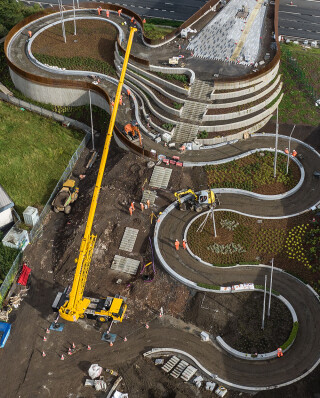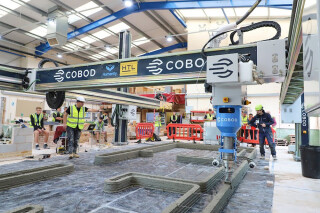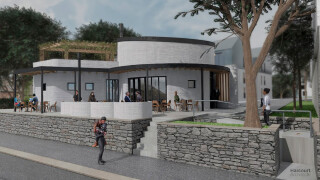3D concrete printing takes its first steps in Scotland
Bam Nuttall has become the first contractor in Scotland to make use of 3D concrete printing – for a flight of stairs that will provide access to the new Sighthill Bridge in Glasgow.
The new bridge is literally several steps up from its predecessor, a narrow weed-infested concrete footbridge over the M8 motorway linking Glasgow City Centre and the mainly residential area of Sighthill.
The new bridge is wider and more open, combining both pedestrian and cycle access across an elegant curvy main span fabricated in weathered steel.
Approaching the bridge from the city centre, south of the motorway, the ground rises steeply. A sinuous cycle track leads up to the bridge in a series of hairpin bends – but pedestrians can take the direct route: up Bam’s new concrete stairs.
Working for Glasgow City Council, Bam had the new stair units manufactured off-site rather than building them in-situ. It craned them all into place in less than a week in September.
Besides drastically reducing the amount of on-site activity, printing the stair components offered numerous benefits. The 3D printing process allows for precise and intricate shapes, which can be tricky with traditional formwork, says Bam.“The removal of moulds and materials reduces waste by 40% compared to traditional methods, keeping costs down and improving carbon efficiency,” the company says.
The staircase will be just as strong as if it had been cast in-situ, says Bam. “However, this innovative method allows the structure to be manufactured in a highly controlled environment, removing concerns around weather and reducing the risks associated with on-site construction.”
Sensors embedded in the concrete add further certainty as to the quality of the mix throughout the manufacturing process.
The steps were printed by Dutch specialist Weber Bemix in its factory in the Netherlands before being shipped to Scotland. Bam – itself Dutch-owned – has a long-standing relationship with the concrete printing experts. Although Bam Nuttall’s staircase is the first such application in Scotland, its Dutch sister company has already built the world’s longest 3D printed concrete bridge with Weber Bemix in Nijmegen, Netherlands, in 2019.

Ian Steele, Bam’s contracts manager for the Sighthill bridge, says: “It’s wonderful to see these 3D concrete printed aspects installed as this iconic bridge takes shape. The printed element saw us manufacture the stairwells offsite, creating strong, one-of-a-kind structures, all while reducing waste and interaction with weather and other elements which can create hold-ups.
“Although this part of the landscaping will ultimately be hidden from site, it marks a huge step forward for Bam in how we modernise our approach to construction – reducing risk, improving efficiency, and driving down our carbon footprint,” he adds.
“The use of this technology is in its infancy, but the aspiration is that interest and application grow to such a degree that we can invest in a UK based printing facility, which would improve how we construct within the UK”.

Printing affordable homes in Accrington
An ambitious £6m scheme in Accrington, Lancashire aims to show 3D printing can deliver greater affordability, efficiency and sustainability in the housing sector.
The Charter Street project is being developed by Building for Humanity, a UK-based not-for-profit housing provider, in collaboration with Dublin-based Harcourt Technologies (HTL).
HTL claims to be the leading provider of 3D concrete printing, or 3DCP, technology in the UK and Ireland.

Its team of architects, engineers, material scientists and construction technologists has been quietly developing and testing the technology over the past 18 months in preparation for its commercial roll-out in both the UK and Ireland.
Charter Street will consist of 46 ‘eco-homes’ comprising one- and two-bedroom apartments and three- and four-bedroom houses. The plan also includes a community centre and training hub, as well as private and communal gardens.
The proposed development will be the first 3DCP residential project in the UK and, when completed, the largest such development in Europe, says HTL. It will demonstrate the benefits that 3DCP technology can bring in terms of cost, time, quality, and sustainability.
The company says that 3DCP can reduce time spent working on site by up to 50% and cuts waste by up to 60%. Labour cost ratio is typically 30% compared to 70% for traditional construction, claims HTL. And overall costs will be cut by 25%.
In preparation for the Charter Street project, HTL has set up a research and development facility in collaboration with nearby Accrington & Rossendale College.
Here, Harcourt architects and structural engineer Lindsay Baxter Design have developed the 3DCP technology to be compliant with the UK building regulations. This will greatly accelerate the uptake of the technology within the UK construction sector, says HTL.
Last month the college hosted a 3DCP introduction course, believed to be the first of its kind in the UK.

The Charter Street development is scheduled to be completed within half the time of traditional construction methodologies. The community centre and training hub will showcase the free-form capabilities of the technology and serve as a meeting and training hub for residents.
The digital accuracy and reliability of the printed superstructure allows other building components, such as doors, windows, floors and roofs to be prefabricated and brought to site during the print sequence. These components are then incorporated to deliver a weather-tight building.
HTL is the strategic partner and exclusive distributor in the UK and Ireland for Cobod International, a Danish manufacturer of 3D construction printing technology.
In addition to the Accrington development, HTL is currently working on several other projects that include private residential developments, tourist retreats, amenity buildings and large scale commercial recreational facilities.
Got a story? Email news@theconstructionindex.co.uk


